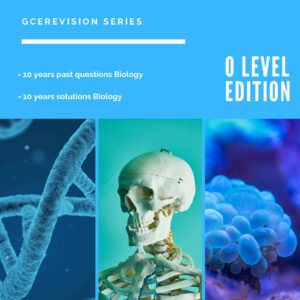To DOWNLOAD CAMEROON GCE JUNE 2001 Biology
Paper 2 click on the link below
June 2001
1. (a) with respect to a named ruminant, discuss digestion in:
(i) the mouth
(ii) the ‘stomach’ and
(iii) the intestine.
(b) What is the importance of roughage in the gut?
2. The data below shows the number of AIDS cases reported in a certain country by year from 1982 to 1989.
| Year | Heterosexuals | Homosexuals | Total cases |
| 1982 | 0 | 3 | 3 |
| 1983 | 1 | 23 | 26 |
| 1984 | 1 | 69 | 77 |
| 1985 | 3 | 152 | 159 |
| 1986 | 7 | 293 | 305 |
| 1987 | 26 | 494 | 648 |
| 19S8 | 33 | 602 | 761 |
| 1989 | 64 | 654 | 851 |
| Total | 135 | 2290 | 2830 |
(a) (i) Use the data given in the table above to draw bar charts t illustrate the number of reported AIDS cases in that country for each risk group (ii) calculate, for both homosexuals and heterosexuals the percentage
of the total AIDS cases they represent for the years 1982, 1984 and 1989.
(b) The table below shows the total HTV positive cases in that same country for September 1989 based on
– figures from the Government’s Diseases Surveillance Centre.
| Category | Total | Percentage Totals |
| Injecting drug users | 1771 | |
| Recipient of blood/blood products | 1206 | |
| Heterosexual contact | 714 | |
| Child of HTV antibody positive/at risk mother | 136 | |
| Male homosexual/bisexual | 5390 | |
| Other/incomplete information | 2001 |
(i) Copy and complete the table above, converting the totals to percentage figure (ii) in question ‘a’ you were
given data concerning reported AIDS cases, whereas in question ‘b’ the data concerns HIV positive cases.
Explain why the latter figures are much higher?
(i) From your bar charts, comment on the trends.in the spread of HIV/ AICDS among heterosexuals and
homosexuals
(ii) Suggest two ways by which the country can prevent the spread of HIV/AIDS among heterosexuals.
(6, 3, 3, 3, 3 2 mks)
3. In guinea pi (Caiva porcello), black coat colour is dominant to brown, and short hair is dominant to
Long hair .Those characteristics are not sex linked. A breeder has only stocks of pure breeding long-haired
and pure breeding short -haired black guinea pigs.’
(a) What do you understand by: (i) linked genes (ii) pure breeding?
(b) Explain clearly the breeding program to be followed (using just two breeding steps) to obtain pure
breeding long-haired guinea pigs.
(c) Show how you will ascertain that you have obtained pure breeding long-haired, black guinea pigs
4. (a) Describe the role of
(i) Carbohydrates
(ii) Proteins and
(iii) Lipids in the structure of plant and animal cells
(b) How do antibodies treat some bacterial diseases?
5. (a) What is alternation of generations?
(b) Give an illustrated account of alternation of generations in the life cycle of a named fem.
(c) How does this Life cycle differ from that of a moss?
(d) What is the importance of water in this life cycle?
6. (a) Describe:
(i) The production and
(ii) The removal of urea in in mammals and ethanol in plants
(b) Explain why mammals produce large, quantities of urine during fright (16, 4 mks)
7. (a) Explain the homeostatic principle
(b) What physiological events would you expect to take place in a diabetic after:
(i) Injecting a small quantity of glucose into the blood stream
(ii) Eating a very salty meat (8,12 mks)
8. (a) State the main features of Arthropods
(b) Explain why insects are so successful in their life on land.
(c). (i) State five ways in which HTV/ AIDS is transmitted
(ii) Why are mosquitoes not likely agents for the transmission of HIV/AIDS? (4, 9, 7 mks)











